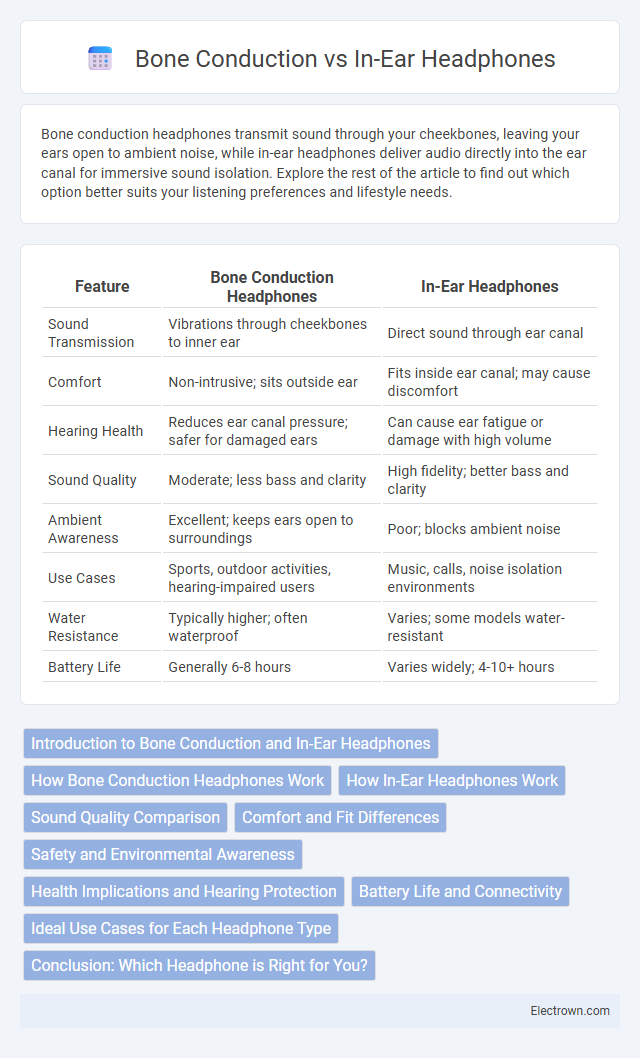Bone conduction headphones transmit sound through your cheekbones, leaving your ears open to ambient noise, while in-ear headphones deliver audio directly into the ear canal for immersive sound isolation. Explore the rest of the article to find out which option better suits your listening preferences and lifestyle needs.
Table of Comparison
| Feature | Bone Conduction Headphones | In-Ear Headphones |
|---|---|---|
| Sound Transmission | Vibrations through cheekbones to inner ear | Direct sound through ear canal |
| Comfort | Non-intrusive; sits outside ear | Fits inside ear canal; may cause discomfort |
| Hearing Health | Reduces ear canal pressure; safer for damaged ears | Can cause ear fatigue or damage with high volume |
| Sound Quality | Moderate; less bass and clarity | High fidelity; better bass and clarity |
| Ambient Awareness | Excellent; keeps ears open to surroundings | Poor; blocks ambient noise |
| Use Cases | Sports, outdoor activities, hearing-impaired users | Music, calls, noise isolation environments |
| Water Resistance | Typically higher; often waterproof | Varies; some models water-resistant |
| Battery Life | Generally 6-8 hours | Varies widely; 4-10+ hours |
Introduction to Bone Conduction and In-Ear Headphones
Bone conduction headphones transmit sound vibrations directly through the cheekbones to the inner ear, bypassing the eardrum for enhanced situational awareness and reduced ear canal irritation. In-ear headphones deliver audio through small earbuds inserted into the ear canal, providing immersive sound isolation and superior bass response. Both technologies cater to distinct listening preferences and environments, with bone conduction favored for outdoor safety and in-ear models suited for immersive audio experiences.
How Bone Conduction Headphones Work
Bone conduction headphones transmit sound vibrations directly through the bones of the skull to the inner ear, bypassing the eardrum entirely. This technology allows users to hear ambient sounds while listening to audio, enhancing situational awareness during activities such as running or cycling. Unlike in-ear headphones that rely on air conduction through the ear canal, bone conduction headphones are especially beneficial for people with certain types of hearing loss or ear infections.
How In-Ear Headphones Work
In-ear headphones work by creating a seal inside the ear canal, which directs sound waves directly to the eardrum, resulting in clear and immersive audio. They use small drivers that convert electrical signals into sound vibrations, maximizing sound isolation and reducing external noise interference. This design provides detailed audio quality and enhanced bass response compared to many other headphone types.
Sound Quality Comparison
Bone conduction headphones typically deliver sound through vibrations transmitted directly to the inner ear, resulting in lower audio fidelity and reduced bass response compared to in-ear headphones. In-ear headphones provide superior sound quality with deeper bass, clearer mids, and crisper highs due to their direct ear canal placement and noise isolation capabilities. Audiophiles and music enthusiasts often prefer in-ear headphones for immersive listening experiences, while bone conduction is favored for situational awareness despite compromised sound clarity.
Comfort and Fit Differences
Bone conduction headphones sit outside the ear, resting on the cheekbones, providing a comfortable option for users who dislike in-ear pressure or irritation. In-ear headphones create a sealed fit inside the ear canal, which can cause discomfort during extended use but offer superior noise isolation. Your choice depends on whether you prioritize open-ear comfort or a snug, immersive fit.
Safety and Environmental Awareness
Bone conduction headphones reduce the risk of hearing damage by allowing you to stay aware of surrounding sounds, enhancing safety especially during outdoor activities. In-ear headphones, while offering superior sound isolation, can increase the risk of accidents by blocking ambient noise and contribute to environmental waste due to frequent replacements and non-recyclable materials. Choosing eco-friendly bone conduction options supports both your hearing health and sustainability efforts by minimizing plastic waste and promoting responsible listening.
Health Implications and Hearing Protection
Bone conduction headphones transmit sound through vibrations on the cheekbones, reducing direct exposure to the eardrum and potentially lowering the risk of ear infections and hearing damage compared to traditional in-ear headphones. Your inner ear is less susceptible to damage from loud volumes with bone conduction, while in-ear headphones can trap moisture and increase the risk of ear canal irritation and hearing loss from prolonged high-volume use. For individuals seeking hearing protection, bone conduction technology offers an alternative that maintains ambient sound awareness, reducing the dangers associated with complete ear canal occlusion.
Battery Life and Connectivity
Bone conduction headphones typically offer longer battery life, often exceeding 8 hours per charge due to their lower power consumption compared to in-ear headphones, which usually last between 4 to 6 hours. Connectivity options for both include Bluetooth 5.0 or higher, providing stable wireless connections and compatibility with smart devices. Bone conduction models may feature multipoint pairing and faster reconnection times, while in-ear headphones often support advanced codecs like aptX or LDAC for enhanced audio quality.
Ideal Use Cases for Each Headphone Type
Bone conduction headphones are ideal for outdoor activities like running or cycling because they allow you to stay aware of your surroundings while enjoying music or calls. In-ear headphones provide superior sound isolation and are perfect for focused listening in noisy environments such as public transport or offices. Your choice depends on whether you prioritize situational awareness or immersive audio experience.
Conclusion: Which Headphone is Right for You?
Bone conduction headphones offer a safer listening option by transmitting sound through your cheekbones, preserving ear health and allowing ambient awareness, ideal for outdoor activities and hearing-impaired users. In-ear headphones provide superior sound isolation and bass quality, making them better suited for immersive music experiences and noise-heavy environments. Your choice depends on whether you prioritize environmental awareness and comfort or high-fidelity audio and noise isolation.
Bone Conduction vs In-Ear Headphones Infographic

 electrown.com
electrown.com